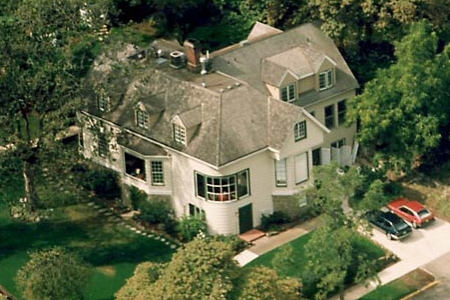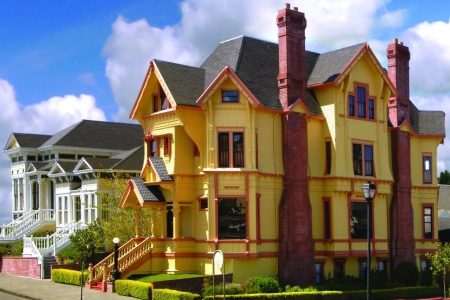Unique Histories
Explore the intruiging history of unique boutique luxury inns. Designed in the late 1800's and early 1900's by renowned architects, these properties echo eras gone by with stylish decor, heirloom orchards and stunning courtyard gardens.
Legendary Catalina Hotel
The location of the Avalon Hotel originally belonged to a pre-World War I gentleman's club. Although little is known about the Pilgrim Club, its luxurious surroundings and aura of mystery have become a local legend. Destroyed in the Great Fire of 1915, the building was reconstructed as a hotel a decade later. In 2003, Carl Lambert and Rock and Kathleen Gosselin purchased the property, looking beyond its ramshackle appearance to the location and spectacular views. Lovingly restored with hand-carved mahogany, etched slate, stained glass, hand-crafted tile and local artwork, the Avalon Hotel has become the pinnacle of Catalina hotels.
Historic Hotel in Upper Lake
The original Tallman House Hotel was built on the current site in the 1870s by Lake County pioneer Rufus C. Tallman. After it burned to the ground in 1895, the hotel was reconstructed the following year, surviving another fire in 1924 that destroyed the entire business section of Upper Lake. Due to its simple western vernacular architectural style, its connection to Lake County pioneers and the central role it played in the development of Upper Lake and Lake County as a transportation, tourism and agribusiness center at the turn of the century, the Tallman Hotel was added to the California Register of Historical Resources as a Point of Historical Interest in 2007.
A Family's Dream
From a grandmother’s humble beginnings, wisdom and grace, came the Willit’s family’s motivation to build FivePine Lodge - a place of serenity that allows guests to reconnect with themselves and the ones they love. Inspiration for the lodge came from the Forestry Building completed in 1905 as part of the Lewis and Clark Exposition in Portland. FivePine was designed with a commitment to following the same scale as the original building, although, tragically 145 fire fighters rushing to the scene couldn’t save the building from total destruction on August 18th,1964. FivePine was then rebuilt “green” which began by surveying every tree on the property and designing buildings that fit the footprint of the treasured forest.
History Continues On
Heceta Lighthouse B&B occupies the Assistant Keeper's Home Duplex, part of the Heceta Head Lightstation on the Central Oregon Coast. Construction started 1892. The First Order Fresnel Lens was lit on March 30, 1894. The Lightstation was home to 1 head lightkeeper, 2 assistant lightkeepers, and their families for decades. No roads existed, only muddy trails and passage by sea. The Keepers were self sustaining and built gardens and a school house for their children and those of nearby homesteading families. Much changed when highway 101 was built, which brought in electricity, motor vehicles, and travelers. Even more changed when WWII occurred and the lightstation became a military base housing many men and their dogs to patrol the coast from Yachats to Florence.
Lightkeeper's no longer live at Heceta Head, but history continues on. The Oregon State Parks manage the Lighthouse tower and beach below. In 1995 the Korgans acquired a permit to run a Bed and Breakfast, with the intention to restore the property and keep it open to the public to share the history of this magical place. The first floor is an Interpretive Center with historic photos and artifacts found on sight, and a 7 Course Breakfast is served every day to overnight guests.
Eugene Pioneer Mansion
The Campbell House was built in 1892 by gold miner and timber owner, John Cogswell for his daughter Idaho. It is one of the earliest and largest houses built in the East Skinner Butte Historic District. The house that John Campbell built in 1892 was owned by the Campbell family for over 100 years. In 1993 Myra and Roger Plant purchased the home, completely renovating it and opening it to the public as a bed & breakfast inn.
Newsom Brothers Mansion
Originally built in 1884 - 1885 in San Francisco as the Murphy House, the original structure of the Carter House was destroyed in the famous San Francisco earthquake and fire of 1906. In 1978, Mark Carter found the plans in a Eureka antique store and decided to build that house. He discovered it had been designed by the famous Newsom Brothers, San Francisco architects who had created the lavish Carson Mansion just up the street in Old Town, Eureka. Crafting the ornate moldings and trim-work by hand, the Carter’s small crew finished the re-creation in 1982.
Mysterious Structure
The Winchester received its moniker due to the "mystery" surrounding much of its structure. In the 1960's the owner noted the many doors walled over, stairs inside closets and windows boarded up. This reminded her of the famous "Winchester Mystery House" in San Jose, California. When the Gibbs began their ambitious project in 1982, among other curiosities they too uncovered 11 windows and 13 doors, but no skeletons! Since the house was locally well known as the "Winchester House" they agreed that indeed they would keep the name.






